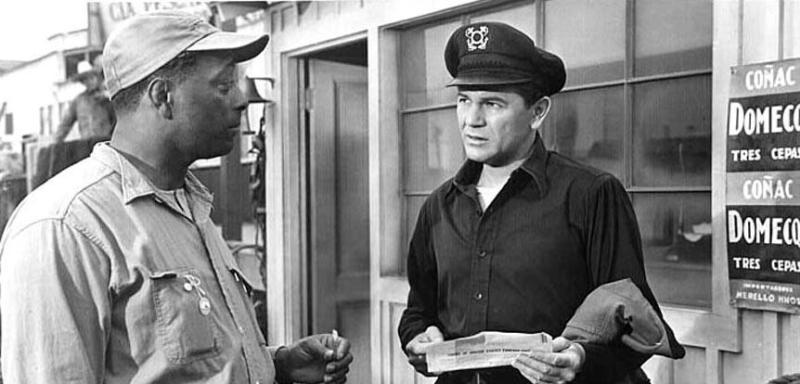You may know Michael Curtiz and Warner Bros. as the minds behind that perennial classic, “Casablanca.”
But there’s an even fresher movie — same director, same studio, similar themes and characters — playing tonight at the Stanford Theatre.
Do not miss Michael Curtiz’ devastating romance-noir “The Breaking Point,” playing at the Stanford on Sept. 20, at 7:30 p.m. — one time only.
This 1950 film was the second time Warner Bros. adapted Ernest Hemingway’s deeply pessimistic “To Have and Have Not” (1937), the story of a lower-class boat skipper forced into shady dealings for the money. The first was in 1944, when Howard Hawks made his “To Have and Have Not” with Humphrey Bogart and Lauren Bacall. Made on the heels of the trio’s masterful “The Big Sleep” (1946), it was a wacky, fun adventure yarn that has precious little to do with Hemingway’s work. The Bogart skipper is compelled to work for an unambiguously righteous cause: He has to smuggle resistance fighters out of Vichy France — not deal with shady Cuban criminals as in the Hemingway book. Like “The Big Sleep,” it’s more of a romantic-screwball caper than anything else: The film is charged up by the super-sexual banter between Bogie and Whistlin’ Bacall.
The 1950 adaptation was Warners’ way of getting closer to the spirit of Hemingway’s original. It loses the ramblingly personal touch of Howard Hawks’ film, but it gains in world-weariness and stylistic dexterity. Here, the unjustly obscure star John Garfield (“Body and Soul”) plays the skipper, Harry Morgan. His best shipmate is Wesley Park, a black man and fellow skipper (Juano Hernandez, MVP). Harry is not a lone wolf like Bogart; he has a wife (heartbreaking Phyllis Thaxter, co-MVP) and two daughters he needs to feed. Most of the film’s first half gains its surreal pull by the exacting accuracy, time and respect it gives to scenes of a tired Harry coming home after a long-day’s boating to his quietly unhappy wife. There are moral quandaries raised when Harry starts to fall for a sultry-voiced, alluring blonde (Patricia Neal). When Thaxter learns about the affair, her character dyes her hair blonde. On paper, the transformation reads like hokum. In 35mm in the Stanford, it swims in an intensely profound sorrow. She looks at her newly blonde self in a mirror like a character in a Douglas Sirk melodrama, and it just about breaks one’s heart to see the desperation so achingly conveyed by Thaxter’s eyes.
At parts taut robbery caper, film noir, domestic family drama, tearjerker and social-conscience picture (Afro-Puerto Rican actor Juano Hernandez [“Intruder in the Dust,” “Stars in My Crown”] shifts from Black presence to absence in two fast, shocking shots that snatch your breath and leave you muttering “Oh my God“), “The Breaking Point” is perhaps the best display of journeyman director Mike Curtiz and his adroit juggling of mature material. He directed so many famous films that appeared in the Stanford’s summer-long Warners festival, including “Yankee Doodle Dandy” (a.k.a., “The Best of James Cagney”), “The Adventures of Robin Hood” (starchy, languid), “Mildred Pierce” (bonkers) and the most famous of them all: “Casablanca.”
Yet the nostalgic wartime wistfulness of “Casablanca” pales in comparison to the depths Curtiz and company plumb in “The Breaking Point.” Like “Casablanca,” a romantic loner with a black buddy is forced to make a decision that may irreparably affect him, his friend and his sweetie(s). But in “The Breaking Point,” the hero exists in a weirder liminal space of flighty hopes and hard-angled truths. It’s a fantasy that hems close to the edges of an uncomfortable postwar American reality: A marriage slowly unwinds, people are tempted and fail to resist, the African-American spirit is snuffed out violently, the next Black generation is left out in the open, ignored. There are lines and performances in this film which will haunt you, shake you, never leave you: Phyllis Thaxter as the desperate woman pleading with husband John Garfield in a knockout long-take (“How will I sleep nights? You know I can’t sleep when you’re gone. I don’t sleep. Don’t leave me all alone”) should be seen by as many people as possible.
It isn’t as well known as Michael Curtiz’s other films — partly to do with the fact that Warner Bros. failed to promote the film following accusations that its leftist star John Garfield was affiliated with the Communist Party. (In highly-publicized testimony, Garfield refused to “name names” and denounced any Communist ties, but the damage was done: He was blacklisted from working in Hollywood and would die of heart failure only two years later in 1952, at the age of 39.) It has fallen by the wayside — unfairly — but a recent restoration and home-video release by the Criterion Collection, as well as its prominence in the Stanford’s Warner Bros. festival curated by David Thomson, brings this emotional masterpiece back for our times.
“The Breaking Point” runs 97 minutes. The Friz Freleng short “Dog Pounded” (1954), starring Tweety Bird and Sylvester the Cat, plays before the main feature. (Two master craftsmen in one night!)
“The Breaking Point” is shot by Ted McCord (“The Sound of Music”) and also stars Wallace Ford, Victor Sen Yung and Juano Hernandez’ own son Juan — who is the center of what may be the most devastating final shot of any Hollywood studio picture I’ve ever seen.
Contact Carlos Valladares at cvall96 ‘at’ stanford.edu.
